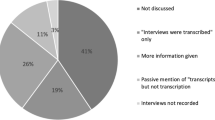Abstract
“Qualitative immediacy” (also termed “quality” in its philosophical sense and “esthetic quality”) is of fundamental importance within the pragmatic conception of meaning as interpretive act, and yet it has been virtually ignored by social scientists. The concept is traced through its foundations in Peirce's philosophy, its development in Dewey's theory of esthetic experience, and its relation to the general pragmatic conception of the self. The importance of the “I” in Mead's view of the self is seen as similar to Firstness in Peirce and esthetic experience in Dewey. Those turning to qualitative approaches ought to consider qualitative immediacy as a genuine addition to our understanding of human communication.
Similar content being viewed by others
References
1967 John Dewey. New York: Washington Square Press, Inc.
1971 Praxis and Action. Philadelphia: University of Pennsylvania Press.
1976 The Restructuring of Social and Political Theory. New York: Harcourt, Brace, Jovanovich.
Blumer, H. 1967 “Society as symbolic interaction.” P. 141 in Jerome G. Manis and Bernard N. Meltzer (eds.), Symbolic Interaction. Boston: Allyn and Bacon.
Csikszentmihalyi, M. and E. Rochberg-Halton 1981 The Meaning of Things: Domestic Symbols and the Self. New York: Cambridge University Press.
1916 Essays in Experimental Logic. Chicago: University of Chicago Press.
1925 Experience and Nature. Chicago: Open Court Publishing Co.
1938 Logic: The Theory of Inquiry. New York: Henry Holt and Co.
1939 Theory of Valuation. Chicago: University of Chicago Press.
1946 Problems of Men. New York: Philosophical Library.
1958 (1934) Art as Experience. New York: Capricorn Books, G.P. Putnam's Sons.
1973 The Interpretation of Cultures. New York: Basic Books.
1980 “Blurred genes: The refiguration of social thought.” American Scholar 49 (Spring): 165–179.
Gonos, G. 1977 “‘Situation’ versus ‘frame’: The ‘interactionist’ and the ‘structuralist’ analyses of everyday life.” American Sociological Review 42 (December):854–867.
Husserl, E. 1973 Cartesian Meditations: An Introduction to Phenomenology. Translated by Dorian Cairns. The Hague: Martinus Nijhoff.
James, William 1950 Principles of Psychology. New York: Dover Publications, Inc. (1890).
1976 “The classic American pragmatists as forerunners to symbolic interactionism.” The Sociological Quarterly 17: 347–359.
1979 “A social behaviorist interpretation of the Median ‘I’.” American Journal of Sociology 85: 261–287.
Locke, John 1959 An Essay Concerning Human Understanding, vol. 1 New York: Dover Publications, Inc.
1932 The Philosophy of the Present. Arthur E. Murphy (ed.), with prefatory remarks by John Dewey. LaSalle, Ill.: The Open Court Publishing Co.
1934 Mind, Self, and Society. Charles Morris (ed.) Chicago: University of Chicago Press (1974).
1938 The Philosophy of the Act. Charles Morris (ed.). Chicago: University of Chicago Press (1972).
Merleau-Ponty, M. 1962 Phenomenology of Perception. Translated by Colin Smith. New York: Humanities Press.
Parsons, M.J. 1980 “James Mark Baldwin and the aesthetic development of the individual.” The Journal of Aesthetic Education 14: 31–50.
Peirce, Charles S. 1931–1958 The Collected Papers of Charles Sanders Peirce, vols, 1–6, C. Hartshorne and P. Weiss (eds.); vols. 7–8, A. Burks (ed.). Cambridge, Mass.: Harvard University Press.
1979a “The meaning of personal arts objects” in J. Zuzanek (ed.), Social Research and Cultural Policy. Ontario: Otium Publications.
Rochberg-Halton, Eugene 1979b Cultural Signs and Urban Adaptation: The Meaning of Cherished Household Possessions. Unpublished PhD dissertation, University of Chicago.
Rochberg-Halton, Eugene 1982 “Situation, structure, and the context of meaning.” The Sociological Quarterly 23:(in press).
Rosensohn, W.L. 1974 The Phenomenology of Charles S. Peirce. Amsterdam: B.R. Grüner.
Schutz, A. 1970 On Phenomenology and Social Relations. Edited and introduced by Helmut R. Wagner. Chicago: University of Chicago Press.
Smith, M.B. 1978 “Perspectives on selfhood.” American Psychologist 33 (December): 1053–1063.
1967 The Forest of Symbols. Ithaca, N.Y.: Cornell University Press.
1975 Revelation and Divination in Ndembu Ritual. Ithaca, N.Y.: Cornell University Press.
Author information
Authors and Affiliations
Additional information
I am grateful for helpful comments from Milton Singer, Kevin McMurtrey, Benjamin Lee, and Thomas Buckley, and for an opportunity to discuss this paper in the seminar on dialogue at the Center for Psychosocial Studies, Chicago. A postdoctoral fellowship (T32 MH 14668) at the Institute for Psychosomatic and Psychiatric Research and Training, Michael Reese Hospital and Medical Center, and the University of Chicago, provided time for the writing of this paper.
Rights and permissions
About this article
Cite this article
Rochberg-Halton, E. Qualitative immediacy and the communicative act. Qual Sociol 5, 162–181 (1982). https://doi.org/10.1007/BF01003527
Issue Date:
DOI: https://doi.org/10.1007/BF01003527




